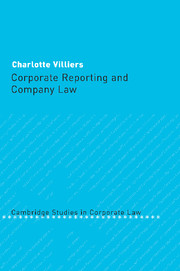Book contents
- Frontmatter
- Contents
- Preface
- Table of legislation
- Table of cases
- Introduction
- PART I GENERAL ISSUES
- PART II FINANCIAL REPORTING
- 6 Financial reporting
- 7 International aspects of financial reporting
- 8 Disclosure in securities markets regulation
- PART III NARRATIVE REPORTING
- PART IV A WAY FORWARD
- Bibliography
- Index
8 - Disclosure in securities markets regulation
Published online by Cambridge University Press: 23 July 2009
- Frontmatter
- Contents
- Preface
- Table of legislation
- Table of cases
- Introduction
- PART I GENERAL ISSUES
- PART II FINANCIAL REPORTING
- 6 Financial reporting
- 7 International aspects of financial reporting
- 8 Disclosure in securities markets regulation
- PART III NARRATIVE REPORTING
- PART IV A WAY FORWARD
- Bibliography
- Index
Summary
Introduction
Disclosure has recently been described as ‘a powerful tool’ for market efficiency and investor protection. Indeed, disclosure requirements form a key regulatory device in the securities markets. Theoretically at least, as was noted in chapter 1, disclosure regulation serves to prevent fraud and to protect investors by allowing them to make informed decisions. This protection increases investor confidence and lays the foundations for a more efficient capital market. At the same time European Union efforts to create a fully integrated capital market have depended on the development of a harmonised regime of minimum disclosure requirements coupled with a policy of mutual recognition. The legislation created at European level has also played a large role in shaping the UK's regulation of financial services and securities markets. Intervention by government and public bodies in this area, resulting in a complex and detailed regulatory framework, has led one observer to note a shift away from company law and private law into a public law of securities regulation. Thus, whilst arguably this chapter is not concerned with company law in its purest sense, its relevance arises, first, from the fact that much of the theoretical debate on disclosure has arisen in the context of securities regulation and, secondly, because trading in securities is an important activity for those companies wishing to raise capital from the public.
This chapter will consider briefly the objectives of disclosure in the area of securities markets.
- Type
- Chapter
- Information
- Corporate Reporting and Company Law , pp. 179 - 202Publisher: Cambridge University PressPrint publication year: 2006



